- Registro
- 22 Jul 2012
- Mensajes
- 407
- Puntos
- 360
https://www.kickstarter.com/projects/258021526/the-sentinel
Sentinel - the next generation wiper
The Sentinel is a high performance dust wiper (seal) for suspension forks of mountainbikes. This device defines the performance of your suspension fork and your ride. In contrast to conventional wipers the Sentinel is completely new in material and design: it is a two-part solution that separates the wiper into body and inserts.
This enables real innovations:
- High-end polymers introduce less friction while providing the best protection
- Coloured bodies to match your fork, your bike, your style
- Choice of inserts for your intended use: race, recreation...
- For service you don't have to replace the body, only the inserts
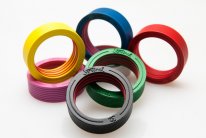
Colour selection
The first batch will be available in black, white, pink, blue, yellow, green and 2 additional "kickstarter"-colours: Our backers (cf. rewards 6&7) will vote and we will produce the two most popular colours. Each backer receiving the Sentinel may then choose among 8 colours.
In the future we are free to produce any colour - for sure we'll again ask our customers!
The Sentinel fits these forks
We will produce the Sentinel for any common model and brand. The first batch of wipers will fit for forks of Rockshox, Fox, Specialized, BOS Engineering and X-Fusion. Available stanchion diameters are 32, 35, 36, 40. In the future we will expand the range.
Why not a conventional wiper?
Dust wipers for suspension forks have to fullfill 3 tasks, which have conflicting requirements to the applied material. As conventional wipers are made out of one piece, engineers had previously compromised in choosing rubber, which is perfect for compensating for tolerances. Tolerances result from the production process, torsion while riding and undoubtedly while installation - no one is able to pound wipers into the casting with a precision of 1/10 mm or 0,004 inches, and that is a lot in sealing !
Through its high friction, however, rubber limits the performance of your fork.
Don't let a compromise limit your ride! Let's change that!
Tasks of wipers:
1. Wipe (keep oil inside, dirt outside)
2. Compensate for tolerances
3. Easy installation into lowers
→ For further technical explanations read below.
Sentinel wipes better!
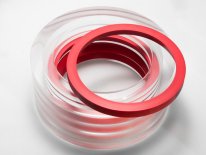
scaled model
We separated the wiper into body and inserts. For each part we chose the perfect material. The inserts are made of polymers which optimize the wiping function while lowering friction. The body is made of polymers optimized for installing the wipers into the fork. The separation also allows something else: colours – bright and also with special effects such as glitter or glow-in-the-dark.
There's another advantage, less obvious and more technical: Tolerances are compensated for by the movement of the inserts inside the body. It is no longer the wiping lips which need to fulfill this role – Sentinel's inserts are now free for their dedicated task: wiping.
Imagine studded tires: To get grip on ice, neither a steel tire nor a rubber tire would work. Pins of steel in a tire of rubber – that's the solution!
The Sentinel's clever combination of two different materials solves the problem of common one-part wipers. The Sentinel features high protection, low friction, better bump sensitivity and wears more slowly.
The construction of the Sentinel ist state-of-the-art in sealing technology: Before we finally get into production, we will of course, adapt effects and function in short and long term tests - to precisely achieve the intended performance.
Adjustable performance: the inserts
The body of the Sentinel offers space for four inserts. In future, the inserts will be produced from different materials also(see below). Depending on your intended use, you can choose material and number of inserts. Two inserts for optimal bump sensitivity, four inserts for optimal protection Also combinations are imaginable: PU inside, PTFE outside.....
Our materials
We will use primarily polyurethane (PU), which is a high performance polymer applied often in sealing technology. PU is resistant to sunlight, oil, water and bacteria. Beyond this, PU features a very high tear strength and wear resistance. If your stanchion for example is slightly damaged it will harder cause significant damage to the inserts. For the Sentinel we use different blends of PU for the inserts and body. We will also apply other high-end materials, which are among the most frictionless materials known.
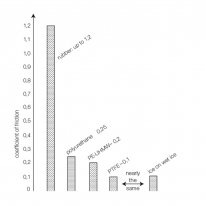
friction polymers - rubber
For the inserts, beyond PU, we will apply ultra-high-molecular-weight Polyethylene and PTFE (also known as "Teflon" by the company DuPont), which is the material of choice to reduce friction. The Sentinel thus runs with materials which are so slick, that they are applied for artificial ice skating rinks or special gecko slides. According to your intended use you can choose the perfect inserts.
For the body we chose a softer and just as robust blend of PU. It is soft enough to guarantee easy installation and to seal the grooves for the inserts effectively. And it is a material that resists hardest environmental influences.

May the Sentinel's materials harm my fork?
In the past riders often were unsure if the material of their wipers and seals would cause damage to their stanchions. A stanchion's surface is anodized aluminium, which is way harder than steel. Harder materials can easily damage softer ones, but not the other way round. So polymers will hardly damage your stanchions. The wearout traces you may be familiar with are caused by dirt and minerals (e.g. quartz) under the wipers which gets rubbed into the surface of the stanchions.
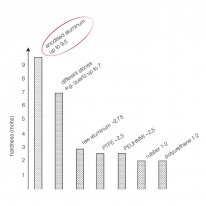
hardness polymers - other materials
Sentinel - made in Germany
The entire manufacturing process from construction to injection molding takes place in Tübingen, Germany. We have all the neccessary know-how, machines and experience. We are nearly independent from other suppliers. We can control quality directly on-site. These advantages are our customers' advantages: fair prices for a high-end product.
What do we need the funding for?
Our company has existed for over 5 years now, we have many more years experience in suspension service and a lot of ideas to improve things. Starting and manufacturing a new product, however demands further investment: development costs, protection of trademarks and patents, laboratory and practice tests as well as raw materials and molding tools for the production itself.
General function of wipers
The movement of a fork has two directions. When the fork moves in, the wiper removes dirt, water etc. When the fork moves out, it has to leave through leftovers, which anyway got into the fork. This complex two-way function of wiping is made through the lip/insert geometry and the resulting pressure to the stanchions – Sentinel is a state-of-the-art construction in sealing technology.

conventional wiper
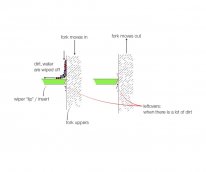
two-way function of a wiper
Wiping function of low friction materials
Friction is the mechanical resistance between different materials when they move against each other. This can be very different: a shoe on sand paper or a piece of soap on the shower floor. For removing dirt from a surface a certain friction is neccessary. In addition to this is the friction of the material itself. When we use materials with less friction, the total friction will be less while the protection and wiping stays the same or improves.
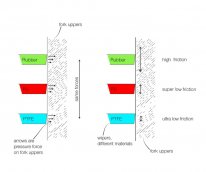
same/improved wiping function - different total friction
Tolerance compensation and materials
Common fork wipers are made of rubber. Rubber is soft and has comparatively high friction (This is perfect for tires' grip to the ground). In sealing technology they achieve siginficantly lower friction and less wear by using polymers for seals and wipers - in many fields of applications.
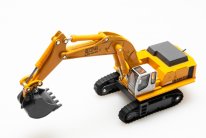
seals and wipers at work
Why thus conventional fork wipers are made from rubber, if that is not the optimal material?
The reason is, that suspension forks (in contrast to machines for example) have several sources of deviation in tolerances:
1. Installation is never precise: the wiper is pounded into the lowers
2. Lowers are cast aluminium-magnesium alloy – casting and subsequent reworking naturally cause production tolerances
3. In older forks, installation space is uneven due to corrosion

examples installation space in lowers
It is production tolerances as well as the need to have a soft material for installation that forces engineers to make a compromise in material. The Sentinel alleviates the need for compromise.
Risks and challenges
Why we think that this will work:
For the development of our wiper we consulted the know-how and methods used in modern sealing technology. Applied materials and insert geometries of the Sentinel are state-of-the art. The construction has been controlled and proven by several experts and is now patent pending. And, of course, we've already tested our technology with prototypes of the Sentinel in our bikes – this made us even more enthusiastic and 100% sure about the project!
Learn about accountability on Kickstarter
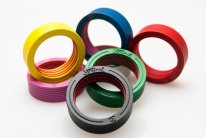
Sentinel - the next generation wiper
The Sentinel is a high performance dust wiper (seal) for suspension forks of mountainbikes. This device defines the performance of your suspension fork and your ride. In contrast to conventional wipers the Sentinel is completely new in material and design: it is a two-part solution that separates the wiper into body and inserts.
This enables real innovations:
- High-end polymers introduce less friction while providing the best protection
- Coloured bodies to match your fork, your bike, your style
- Choice of inserts for your intended use: race, recreation...
- For service you don't have to replace the body, only the inserts

Colour selection
The first batch will be available in black, white, pink, blue, yellow, green and 2 additional "kickstarter"-colours: Our backers (cf. rewards 6&7) will vote and we will produce the two most popular colours. Each backer receiving the Sentinel may then choose among 8 colours.
In the future we are free to produce any colour - for sure we'll again ask our customers!
The Sentinel fits these forks
We will produce the Sentinel for any common model and brand. The first batch of wipers will fit for forks of Rockshox, Fox, Specialized, BOS Engineering and X-Fusion. Available stanchion diameters are 32, 35, 36, 40. In the future we will expand the range.
Why not a conventional wiper?
Dust wipers for suspension forks have to fullfill 3 tasks, which have conflicting requirements to the applied material. As conventional wipers are made out of one piece, engineers had previously compromised in choosing rubber, which is perfect for compensating for tolerances. Tolerances result from the production process, torsion while riding and undoubtedly while installation - no one is able to pound wipers into the casting with a precision of 1/10 mm or 0,004 inches, and that is a lot in sealing !
Through its high friction, however, rubber limits the performance of your fork.
Don't let a compromise limit your ride! Let's change that!
Tasks of wipers:
1. Wipe (keep oil inside, dirt outside)
2. Compensate for tolerances
3. Easy installation into lowers
→ For further technical explanations read below.
Sentinel wipes better!

scaled model
We separated the wiper into body and inserts. For each part we chose the perfect material. The inserts are made of polymers which optimize the wiping function while lowering friction. The body is made of polymers optimized for installing the wipers into the fork. The separation also allows something else: colours – bright and also with special effects such as glitter or glow-in-the-dark.
There's another advantage, less obvious and more technical: Tolerances are compensated for by the movement of the inserts inside the body. It is no longer the wiping lips which need to fulfill this role – Sentinel's inserts are now free for their dedicated task: wiping.
Imagine studded tires: To get grip on ice, neither a steel tire nor a rubber tire would work. Pins of steel in a tire of rubber – that's the solution!
The Sentinel's clever combination of two different materials solves the problem of common one-part wipers. The Sentinel features high protection, low friction, better bump sensitivity and wears more slowly.
The construction of the Sentinel ist state-of-the-art in sealing technology: Before we finally get into production, we will of course, adapt effects and function in short and long term tests - to precisely achieve the intended performance.
Adjustable performance: the inserts
The body of the Sentinel offers space for four inserts. In future, the inserts will be produced from different materials also(see below). Depending on your intended use, you can choose material and number of inserts. Two inserts for optimal bump sensitivity, four inserts for optimal protection Also combinations are imaginable: PU inside, PTFE outside.....
Our materials
We will use primarily polyurethane (PU), which is a high performance polymer applied often in sealing technology. PU is resistant to sunlight, oil, water and bacteria. Beyond this, PU features a very high tear strength and wear resistance. If your stanchion for example is slightly damaged it will harder cause significant damage to the inserts. For the Sentinel we use different blends of PU for the inserts and body. We will also apply other high-end materials, which are among the most frictionless materials known.

friction polymers - rubber
For the inserts, beyond PU, we will apply ultra-high-molecular-weight Polyethylene and PTFE (also known as "Teflon" by the company DuPont), which is the material of choice to reduce friction. The Sentinel thus runs with materials which are so slick, that they are applied for artificial ice skating rinks or special gecko slides. According to your intended use you can choose the perfect inserts.
For the body we chose a softer and just as robust blend of PU. It is soft enough to guarantee easy installation and to seal the grooves for the inserts effectively. And it is a material that resists hardest environmental influences.

May the Sentinel's materials harm my fork?
In the past riders often were unsure if the material of their wipers and seals would cause damage to their stanchions. A stanchion's surface is anodized aluminium, which is way harder than steel. Harder materials can easily damage softer ones, but not the other way round. So polymers will hardly damage your stanchions. The wearout traces you may be familiar with are caused by dirt and minerals (e.g. quartz) under the wipers which gets rubbed into the surface of the stanchions.

hardness polymers - other materials
Sentinel - made in Germany
The entire manufacturing process from construction to injection molding takes place in Tübingen, Germany. We have all the neccessary know-how, machines and experience. We are nearly independent from other suppliers. We can control quality directly on-site. These advantages are our customers' advantages: fair prices for a high-end product.
What do we need the funding for?
Our company has existed for over 5 years now, we have many more years experience in suspension service and a lot of ideas to improve things. Starting and manufacturing a new product, however demands further investment: development costs, protection of trademarks and patents, laboratory and practice tests as well as raw materials and molding tools for the production itself.
General function of wipers
The movement of a fork has two directions. When the fork moves in, the wiper removes dirt, water etc. When the fork moves out, it has to leave through leftovers, which anyway got into the fork. This complex two-way function of wiping is made through the lip/insert geometry and the resulting pressure to the stanchions – Sentinel is a state-of-the-art construction in sealing technology.

conventional wiper

two-way function of a wiper
Wiping function of low friction materials
Friction is the mechanical resistance between different materials when they move against each other. This can be very different: a shoe on sand paper or a piece of soap on the shower floor. For removing dirt from a surface a certain friction is neccessary. In addition to this is the friction of the material itself. When we use materials with less friction, the total friction will be less while the protection and wiping stays the same or improves.

same/improved wiping function - different total friction
Tolerance compensation and materials
Common fork wipers are made of rubber. Rubber is soft and has comparatively high friction (This is perfect for tires' grip to the ground). In sealing technology they achieve siginficantly lower friction and less wear by using polymers for seals and wipers - in many fields of applications.

seals and wipers at work
Why thus conventional fork wipers are made from rubber, if that is not the optimal material?
The reason is, that suspension forks (in contrast to machines for example) have several sources of deviation in tolerances:
1. Installation is never precise: the wiper is pounded into the lowers
2. Lowers are cast aluminium-magnesium alloy – casting and subsequent reworking naturally cause production tolerances
3. In older forks, installation space is uneven due to corrosion

examples installation space in lowers
It is production tolerances as well as the need to have a soft material for installation that forces engineers to make a compromise in material. The Sentinel alleviates the need for compromise.
Risks and challenges
Why we think that this will work:
For the development of our wiper we consulted the know-how and methods used in modern sealing technology. Applied materials and insert geometries of the Sentinel are state-of-the art. The construction has been controlled and proven by several experts and is now patent pending. And, of course, we've already tested our technology with prototypes of the Sentinel in our bikes – this made us even more enthusiastic and 100% sure about the project!
Learn about accountability on Kickstarter

Última edición:

